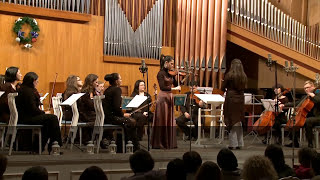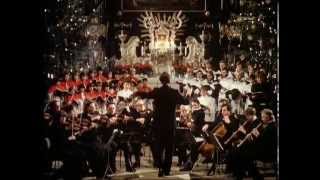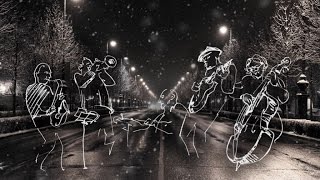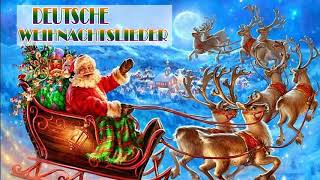Beginning of Winter and beginning of Christmas
Recommended music videos for initiation to classical music
Silent Night (Stille Nacht) is a popular Austrian Christmas carol originally composed in German by Austrian schoolteacher and organist Franz Xaver Gruber ; the lyrics were written by Austrian priest Joseph Mohr . In 2018, on the occasion of the carol's bicentennial, UNESCO declared it an Intangible Cultural Heritage of Humanity . The song has been recorded by many singers and in various musical genres; Bing Crosby 's version is the most popular worldwide and is the third best-selling single in history. The music performed today differs slightly from Gruber 's original, particularly in the final notes.
Today we are treated to the German soprano Diana Damrau accompanied by the Knabenchor Hannover choir and the NDR Radiophilharmonie orchestra with conductors Riccardo Minasi and Richard Whilds.
Antonio Vivaldi (1678-1741) was an Italian priest, violinist and composer known as the Red Priest (“il prete rosso”). He was born in Venice and as a child he learned to play the violin with his father. At the age of 15 he entered the Seminary and once ordained a priest, he could barely attend to his religious obligations due to his health problems; so he was appointed violin teacher in an orphanage where he gave theoretical and instrumental classes. At the age of 40 he was appointed Chapel Master in Mantua where he wrote his famous Four Seasons . From there he moved to Milan , then to Rome , later to Venice again and finally to Vienna where he died. Throughout his life he composed almost 800 works, of which half were concertos, 40 operas, 60 religious works and numerous sonatas.
The Four Seasons , Vivaldi 's best-known work, is a set of four concertos for violin and orchestra (each concerto is dedicated to a season: Spring, Summer, Autumn, and Winter). Although, unusually for the time, Vivaldi published the concertos with accompanying poems describing what he wanted to represent in relation to each of the seasons, it provides one of the earliest and most detailed examples of what would later be called programmatic or descriptive music —music with a narrative element.
Today we offer Winter , explained by Vivaldi himself: I ALLEGRO (0´00´´). Icy to shiver in the silver snow at the harsh blow of the horrid wind; to run, beating feet all the time; and for the superb chattering of teeth . II LARGO (3´34´´) To be by the fire, calm and happy, while outside the rain wets a hundred times. III ALLEGRO (5´47´´) To walk on the ice, now slow; for fear of falling, advance carefully. Go firmly, slip, fall to the ground; again go on the ice and run fast without the ice breaking, and crumbling. To feel that it comes out of the iron doors; Sirocco, Boreas, and all the winds at war. This is winter, but such, what joy it brings us.
This Winter 's performance is offered to us by violinist Olga Boico accompanied by the National Chamber Orchestra of Moldova under the baton of maestro Silvia Tabor
Bartolomé María de Ercilla (1863-1898) was born in Durango , Bizkaia, the son of the former mayor of the town, Juan Timoteo de Ercilla y Cenarruzabeitia ; this facilitated his relationship with some of the main standard-bearers of Basque culture at the time, such as Miguel de Unamuno, Felipe Arrese and Arturo Campion . He was the first director of the Durango Music Band , as well as the creator of the Iparraguirre Orfeón . He combined his compositional work with teaching, playing the piano, directing instrumental and vocal ensembles and even organizing cultural events, such as the Musical Evenings of the Círculo de la Amistad de Bilbao . He died in Durango , of natural causes according to the chronicles, when the composer was only 35 years old.
Mesias Sarritan . On Christmas Day 1892 his best-known work was premiered, the popular carol throughout the Basque Country Mesias Sarritan written for three mixed voices and organ with zortziko for tenor solo. It is dedicated to Castor de Gorrichategui , a professor from Berriz who was his disciple, has lyrics by the priest Balbino de Garitaonandía , chaplain of the Durango Hospital , and is published with the data of opus no. 51. This numbering indicates that, by the age of 29, Ercilla had composed at least that number of works, mainly written for piano, band, keyboard and voice, choir, orchestra and arrangements of works by other authors. (Extracted from the article by Luis Orduña Ridruejo , Director of the Tabira Band of Durango, published by the magazine Astola) .
Barbara Hendricks (born 20 November 1948 in Stephens, Arkansas) is a lyric soprano and jazz performer. She is also a notable exponent of Mozart operas and a first-rate recitalist. She made her European debut in 1974, singing at the Glyndebourne Festival and in the USA at the San Francisco Opera and the Santa Fe Opera . Since then, she has sung in the most important opera houses in the world. In 1987 she was awarded the French Legion of Honour and in 2000 she received the Prince of Asturias Award for the Arts . She is a member of the jury for the International Prize for Catalonia awarded by the Generalitat de Catalunya . Hendricks has worked intensively for refugees and supports the work of the United Nations High Commissioner for Refugees (UNHCR).
John Williams (1932) is an American composer, conductor, pianist and trombonist, considered one of the most prolific composers of soundtracks in the history of cinema; he has composed some of the most famous and recognizable of all time such as: Star Wars, Harry Potter, Jaws, Catch Me If You Can, ET, Superman, Indiana Jones, Jurassic Park, Schindler's List, Home Alone and others. He has also composed music for various Olympic Games , numerous television series, newsreels and several concert works . He has won the Oscar five times and has 52 nominations to his name, making him the second man with the most nominations for the highest award in the seventh art after Walt Disney .
Christmas album. The two artists mentioned above join forces today to offer us a select and varied repertoire of Christmas songs.
Recommended classical music videos
Ástor Piazzolla (1921–1992) was born in Mar de Plata , Argentina . At the age of three he moved with his family to New York and at the age of thirteen he met Carlos Gardel . On his return to Argentina , he received lessons from Ginastera for six years while he regularly attended the Café Germinal where tango music was the daily bread. He was part of various groups, where purists considered his innovations as the “murder of tango”. With a certain dose of pessimism he moved to Paris , where he met Nadia Boulanger who made him believe in himself and in the possible conjunction of tango with classical music . He returned to Buenos Aires with such activity that in 1973 he suffered a heart attack; despite this he continued with his compositions and recordings until 1990 when he suffered a thrombosis in Paris that he would not be able to overcome.
The Cuatro Estaciones Porteñas , also known as Estaciones Porteñas or The Four Seasons of Buenos Aires , are a set of four tango compositions written by Ástor Piazzolla , with occasional references to Vivaldi 's Four Seasons , which were originally conceived and treated as different compositions rather than a suite, although Piazzolla performed them together from time to time. The pieces were composed for his quintet of violin (viola), piano, electric guitar, double bass and bandoneon. By giving the adjective porteño , referring to those born in Buenos Aires , Piazzolla gives an impression of the four seasons in Buenos Aires .
Today the Norwegian violinist Mari Samuelsen offers us Piazzola 's Invierno Porteño .
Johann Sebastian Bach (1685-1750) Today we meet one of the three giants of Western music along with Mozart and Beethoven . He was a German violinist, organist, conductor and composer, born in Eisenach into the most prominent musical family in history. In 1703 he got his first job in Arndstat and in 1707 he moved to Mülhausen as an organist, where he married his cousin Maria Barbara with whom he had seven children. After the death of his wife in 1720, after a year and a half of widowhood, he married again to Maria Magdalena with whom he would have another thirteen children. In 1723 he moved to Leipzig where he would reside until his death at the age of 65. His influence has been notable on Haydn , Mozart , Beethoven , Mendelssohn , Schumann , Chopin ... and many other renowned composers.
An oratorio is a dramatic musical genre, unlike an opera , without staging, costumes or sets. Generally composed for solo voices, choir and symphony orchestra, sometimes with a narrator, its subject matter is frequently religious (stories from the Bible or the Gospel , from the life of Jesus or the lives of saints, etc.), but can also be secular (mythological heroes, historical themes, a hymn to nature, etc.). Its main characteristics are generally: A) A general structure in several parts, frequently three, (eventually preceded by an instrumental prelude). B) The presence of a narrator (external to the action or identified with a character). C) The alternation between the sung parts of arias and recitatives.
The Christmas Oratorio is composed of six cantatas to be performed on different days of the Christmas holidays: 1. The Nativity (December 25). 2. The Announcement to the Shepherds (December 26). 3. The Adoration of the Shepherds (December 27). 4. The Circumcision and Baptism of Jesus (January 1). 5. The Journey of the Magi (the first Sunday in January). 6. The Adoration of the Magi (January 6). Despite this, it is usually presented as a single whole or as two sets: cantatas 1, 2 and 3 on the one hand and cantatas 4, 5 and 6 on the other.
Today we offer the set of the first three cantatas (I: 1´02´´.-. II: 28´18´´.-. III: 56´42´´) conducted by Nikolaus Harnoncourt (1929-2016), an Austrian conductor specialized in baroque and classical music, and a pioneer in the interpretation of his works with period instruments and in the application of objective and historicist musicological criteria.
Max Christian Friedrich Bruch (1838 – 1920), known as Max Bruch , was a German composer and conductor. He is best known for his Violin Concerto No. 1 and his Scottish Fantasy. In 1852, when he was only 14, he composed his first symphony and a string quartet, which earned him a prize from the Mozart Foundation in Frankfurt am Main and a scholarship. He worked as a music teacher and conductor in various European cities. Bruch was awarded honorary professorships by the universities of Cambridge and Berlin , where he joined the Academy of Fine Arts as a member of the board. In the last ten years of his life, Bruch resigned from his positions and devoted himself entirely to composition, dying at the age of 82.
Catalogue of the works of Max Bruch . His works are classified by their Opus number (from the Latin opus 'work'; op. abbreviation) which is a term used in music to catalogue the works of most composers since the 17th century .
Gruss an die heilige Nacht (Greetings on Christmas Eve) op 62 , written in 1892, is based on a poem by Robert Prutz . Its five verses alternate between chorus and contralto solo and the combination of both to form an extended work characterized by cantabile leadership of the singing voices and romantic harmony. The tonal climax of the middle verse is extremely effective, allowing us to experience how “all the heavens opened, shining on sea and land.” Max Bruch loved the full, warm sound of the orchestral accompaniment, which can also be heard in the piano version. (Excerpted from the Hamburg Symphony article.)
Today we offer the second part of this cantata in a version by the Monteverdi Choir of Würzburg accompanied by the Mainphilharmonie of Würzburg conducted by maestro Matthias Beckert .
Ariel Ramírez (1921-2010) is one of the most important figures of Argentine nativism. He studied piano and composition, and at the age of 20, encouraged by Atahualpa Yupanqui , he travelled throughout the country, making contact with the different musical expressions of each region. Nine years later he made a four-year trip through Europe offering various concerts of music from his land; on his return to Argentina he formed a company made up of musicians and dancers with which he would tour the country for 20 years; after this stage he performed as a piano soloist in countless recitals in which he interspersed his own works. He wrote numerous songs and works among which the world-famous Misa Criolla stands out.
The Cantata , in its origin, is a musical piece written to be “sung” by one or more solo voices with instrumental accompaniment and generally articulated by several movements and sometimes with a choir. Later the cantata evolved and adopted freer forms and complexions, as in the case that concerns us today.
Our Christmas is a cantata with lyrics by Félix Luna and music by Ariel Ramírez structured in six scenes or musical movements: I (0´04´´) THE ANNUNCIATION .-. II (4´15´´ ) THE PILGRIMAGE .-. III (10´03´´) THE BIRTH .-. IV (16´32´´) THE SHEPHERDS .-. V (18´45´´) THE THREE WISE MEN .-. VI (21´16´´) THE FLIGHT. Today it is offered to us by the Opera & Philharmonic Bialystok (Poland) accompanied by the Sierra Manta Group directed by the maestro Violetta Bielecka
Recommended music videos for all tastes
Christmas music encompasses a variety of musical genres that are regularly performed or heard during the Christmas season. Music associated with Christmas may be purely instrumental, or in the case of carols or songs may employ lyrics that range in theme from the birth of Jesus Christ , through gift-giving and joy, to cultural figures such as Olentzero , Santa Claus , or the Three Wise Men , among other topics. Many songs simply have a winter or seasonal theme, or have been adopted into the canon for other reasons.
Performances of Christmas music at public concerts, churches, shopping malls, city streets, and private gatherings are an integral staple of the Christmas season in many cultures around the world. Radio stations often turn to a 24/7 Christmas music format in advance of the holiday, as part of a phenomenon known as “Christmas sneak peek.”
Recommended peculiar videos
David Fang (1986) is a Chinese composer of stage music, film, television and audiovisuals. Born in Shanghai and raised in New York , he began studying violin as a child with his father, a professional musician, and formalized his studies in music and music technology in New York . At the age of 12 he wrote his first orchestral work and from then on he would continue composing music for video games and other things. When he was only fourteen years old, he wrote the ballet The Four Seasons , of which we present today its Winter staged by Shanghai Dance Academy.
Adolphe Adam (1803-1856) was a French composer born in Paris and author of abundant scenic music. He was the son of the renowned pianist and professor at the Paris Conservatoire , Lois Adam , with whom he began his musical studies. As a young man, he joined the orchestra of the Théâtre du Gymnase where he became a timpanist and choirmaster. At the age of 18 he entered the Paris Conservatoire and at 20 he was composing songs for the Parisian vaudevilles . His first successes came as an adult with the ballet Giselle and the opera Si j'étais roi ; although by then he had already written several ballets and operas.
Giselle is a ballet in two acts with music by Adolphe Adam , choreography by Jules Perrot and Jean Coralli and libretto by Théophile Gautier and Jules-Henri Vernoy, based on the play De l'Allemagne (1835) by Heinrich Heine . Giselle is a peasant girl of great beauty and extreme innocence; deceived and betrayed, her heart breaks, falling into a despair that will drag her towards madness and death. Giselle is one of the masterpieces of ballet blanc , a ballet scene in which all the members of the corps de ballet appear dressed in white. Since the times of Romantic ballet, these scenes have been populated by ghosts, dryads, sylphs, fairies or similar creatures.
Today we present some scenes from Act I starring Svetlana Zakharova and Roberto Bolle
The National Folkloric Ballet (BFN) is an Argentine folkloric dance artistic company created in 1986 under the direction of Santiago Ayala and Norma Viola , both leaders in the field of Argentine folkloric dance; the dance troupe made its first performance on July 9, 1990 at the Teatro Colón in Buenos Aires . It has toured Argentine cities and festivals, such as the National Folklore Festival of Cosquín, the National Chamamé Festival , the National Malambo Festival and the National and International Festival of Doma and Folklore of Jesús María and has presented its art in exhibitions in Albania, Brazil, Chile, Colombia, Spain, France, Japan, Mexico, Paraguay, Portugal and Switzerland .
Pyotr Tchaikovsky (1840-1893) was a Russian composer who graduated from the St. Petersburg Conservatory and wrote works in various genres, although where he achieved his greatest success was with his ballets. In 1859 he obtained a position as a civil servant in the Ministry of Justice , which he would leave after three years in order to devote himself solely to music. His personal life was plagued by continuous crises after the death of his mother and by his repressed homosexuality, which forced him to enter into a marriage that only lasted a few months. He wrote more than 150 compositions, including piano works, quartets, suites, symphonies, concertos, chorals, cantatas, operas and ballets. He died at the age of 53 and is considered one of the greatest composers in history.
The Nutcracker , the work we are watching today, is a fairy tale/ballet usually performed during the Christmas holidays. The premiere took place at the Mariinsky Theatre in St. Petersburg , but before its premiere, an orchestral suite with eight of its numbers had already been created. The plot is based on a tale by ETA Hoffmann adapted by Alexandre Dumas ; the story takes place at Christmas time when a magician arrives at Clara 's home with a box of puppets and the Nutcracker doll, who is actually a prince. After many incidents, it turns out that it has all been a dream of Clara 's.
Today we offer the 2019 version of the Russian National Ballet directed by Sergei Radchenko .
Recommended music videos for children
Various Wikipedia articles have been used to write these texts.
The texts of Videomusicalis are written in Basque, Spanish and English.



































